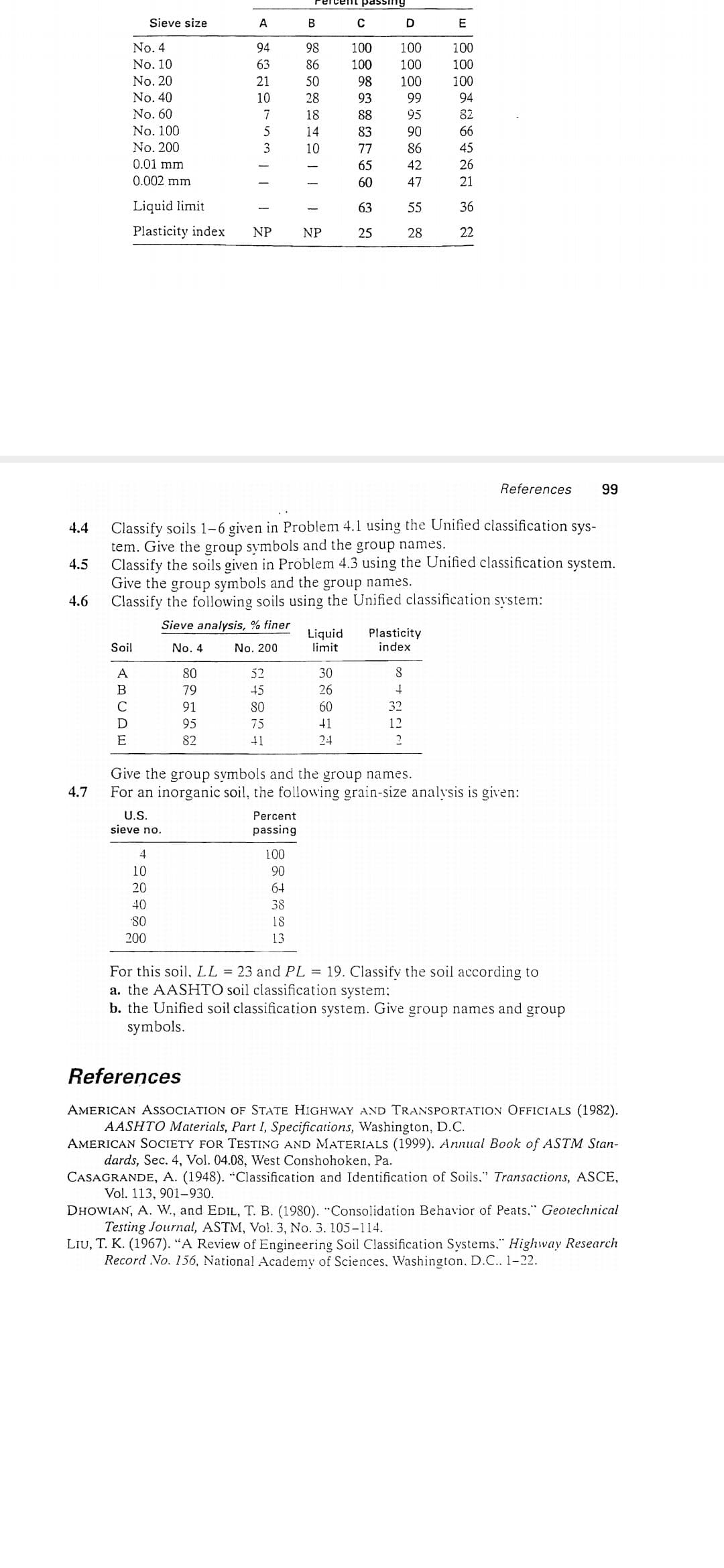4.6 Classify the following soils using the Unified classification system: Sieve analysis, % finer Liquid limit Plasticity index Soil No. 4 No. 200 80 52 30 8 79 45 26 91 80 60 32 95 75 41 12 82 41 24 2 Give the group symbols and the group names. ABCDE
4.6 Classify the following soils using the Unified classification system: Sieve analysis, % finer Liquid limit Plasticity index Soil No. 4 No. 200 80 52 30 8 79 45 26 91 80 60 32 95 75 41 12 82 41 24 2 Give the group symbols and the group names. ABCDE
Chapter2: Loads On Structures
Section: Chapter Questions
Problem 1P
Related questions
Question

Transcribed Image Text:passing
Sieve size
A
D
E
No. 4
94
98
100
100
100
No. 10
63
86
100
100
100
No. 20
100
94
21
50
98
100
No. 40
10
28
93
99
No. 60
No. 100
7
18
88
95
82
14
83
90
66
No. 200
3
10
77
86
45
0.01 mm
65
42
26
0.002 mm
60
47
21
Liquid limit
63
55
36
Plasticity index
NP
NP
25
28
22
References
99
Classify soils 1-6 given in Problem 4.1 using the Unified classification sys-
tem. Give the group symbols and the group names.
Classify the soils given in Problem 4.3 using the Unified classification system.
Give the group symbols and the group names.
Classify the following soils using the Unified classification system:
4.4
4.5
4.6
Sieve analysis, % finer
Liquid
limit
Plasticity
index
Soil
No. 4
No. 200
A
80
52
30
79
45
26
91
80
60
32
95
75
41
12
E
82
41
24
2
Give the group symbols and the group names.
For an inorganic soil, the following grain-size analysis is given:
4.7
U.S.
Percent
sieve no.
passing
4
100
10
90
20
64
40
38
80
18
200
13
For this soil, LL = 23 and PL = 19. Classifv the soil according to
a. the AASHTO soil classification system:
b. the Unified soil classification system. Give group names and group
symbols.
References
AMERICAN ASSOCIATION OF STATE HIGHWAY AND TRANSPORTATION OFFICIALS (1982).
AASHTO Materials, Part I, Specifications, Washington, D.C.
AMERICAN SOCIETY FOR TESTING AND MATERIALS (1999). Annual Book of ASTM Stan-
dards, Sec. 4, Vol. 04.08, West Conshohoken, Pa.
CASAGRANDE, A. (1948). “Classification and Identification of Soils." Transactions, ASCE,
Vol. 113, 901-930.
DHOWIAN, A. W., and EDIL, T. B. (1980). "Consolidation Behavior of Peats." Geotechnical
Testing Journal, ASTM, Vol. 3, No. 3. 105-114.
LIU, T. K. (1967). “A Review of Engineering Soil Classification Systems." Highway Research
Record No. 156, National Academy of Sciences. Washington. D.C.. 1-22.
Expert Solution
This question has been solved!
Explore an expertly crafted, step-by-step solution for a thorough understanding of key concepts.
This is a popular solution!
Trending now
This is a popular solution!
Step by step
Solved in 5 steps with 1 images

Knowledge Booster
Learn more about
Need a deep-dive on the concept behind this application? Look no further. Learn more about this topic, civil-engineering and related others by exploring similar questions and additional content below.Recommended textbooks for you


Structural Analysis (10th Edition)
Civil Engineering
ISBN:
9780134610672
Author:
Russell C. Hibbeler
Publisher:
PEARSON

Principles of Foundation Engineering (MindTap Cou…
Civil Engineering
ISBN:
9781337705028
Author:
Braja M. Das, Nagaratnam Sivakugan
Publisher:
Cengage Learning


Structural Analysis (10th Edition)
Civil Engineering
ISBN:
9780134610672
Author:
Russell C. Hibbeler
Publisher:
PEARSON

Principles of Foundation Engineering (MindTap Cou…
Civil Engineering
ISBN:
9781337705028
Author:
Braja M. Das, Nagaratnam Sivakugan
Publisher:
Cengage Learning

Fundamentals of Structural Analysis
Civil Engineering
ISBN:
9780073398006
Author:
Kenneth M. Leet Emeritus, Chia-Ming Uang, Joel Lanning
Publisher:
McGraw-Hill Education


Traffic and Highway Engineering
Civil Engineering
ISBN:
9781305156241
Author:
Garber, Nicholas J.
Publisher:
Cengage Learning